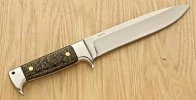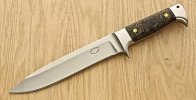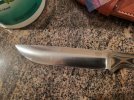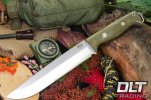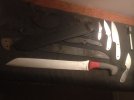- Joined
- Apr 25, 2022
- Messages
- 113

I'm designing this knife for a friend of mine, and I am having some trouble on the blade. I drew it on 1/4" graph paper if that helps visualize it. I am thinking of just grinding all the way up and if I think it needs it then I could do a top swedge. I am worried that if I keep it flat then it will look like a big empty space, but I am also a little worried that the swedge will make it look like a giant dagger, and I don't like that look. I am looking to keep the general shape of the blade, but I will probably tweak it a bit as I work on it, especially on the point end. I am going to ease off the curve so it will end up between the current mark and the erased section. I am going to satin finish it, if that helps. I don't want to do any sort of hollow grinding on it, but I did consider doing a small fuller along the spine. I'm not good enough at hollow grinding to put it on something for someone else, so I want to keep it to a flat grind. I may also just grind the primary bevel and then go from there. If I think it looks good then I will stop there, but if it could use something else then I might add something else. What do you think? Also, does anyone have any tips for designing bigger knives? I mostly do smaller bushcrafter-style knives, so it feels like there is a lot of empty space whenever I do something this big. Thanks!

